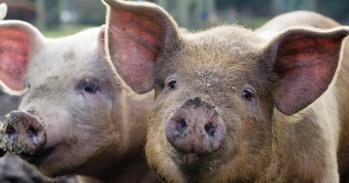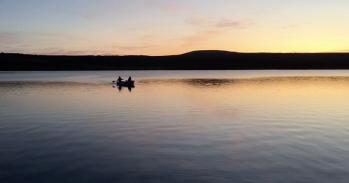By using advanced imaging technology, scientists are able to map on an unprecedentedly large scale – and in remarkably accurate detail - what is happening to these precious resources worldwide.
By using advanced imaging technology, scientists are able to map on an unprecedentedly large scale – and in remarkably accurate detail - what is happening to these precious resources worldwide.
Lidar involves the firing of laser pulses at very high frequency (many thousands per second) and detecting the backscatter off different objects.
Dr Will Simonson
Forests are essential for life on earth. They provide a habitat for a myriad of different plant and animal species – too numerous to count but certainly running into millions. Forests are also home to some 5–17 per cent of the global human population, a fact easily overlooked from the urban perspective. How worldwide forests are changing, and the serious threats they face, is the focus of Cambridge University’s Forest Ecology and Conservation Group (FECG), Department of Plant Sciences.
“Whether we live among trees or not, we all depend on forests. They are the lungs of the biosphere, and in providing oxygen function as important sinks of atmospheric carbon dioxide, helping to reduce and offset the build-up of this climate-changing ‘greenhouse’ gas. Forests also have important roles in soil-building and conservation, flood control, and fluxes of chemical elements between the bedrock, soil and atmosphere,” said Dr David Coomes, head of FECG.
Our timber comes from forests – and so too do many foods, medicines and other products. Forests represent the provisioning, regulating, supporting ‘ecosystem services’, upon which economists now attempt to put monetary value in efforts to recognise their importance in the market economy, and further incentivise their protection. Intrinsic, inspirational and spiritual values of forests cannot be costed in the same way, but lend further weight to the imperative of their conservation.
Although forests are so valuable, they are all-too-frequently threatened. The world’s largest rainforest, in Amazonia, is home to over half of the world’s terrestrial fauna and flora, but this has not stopped a massive encroachment of cattle ranching. In Sumatra, over 95 per cent of the lowland forests have been logged and planted with oil palms for the commercial food industry and biodiesel. Current rates of loss of tropical humid forests equate to a 100 m wide strip of land being devoured at 66 km per hour.
Forests also face less obvious threats. Introduced ‘alien’ plants can invade forests and compromise their integrity and functioning. Droughts and fires can impact on the make-up of tree mixtures, and turn forests from carbon sinks to carbon sources, exacerbating the cause of climate change.
FECG aims to understand these challenges better. Dr Coomes explained: “We look at change from a bottom-up approach, working from the first principles of how trees establish, grow, compete with one another for resources, reproduce and die. Repeat measurements from permanent forest plots, sometime as part of national forest inventories, can make an important contribution to knowledge of forest dynamics. Such information provides the critical numbers to plug into computer models, which take a mixed stand of trees and simulate what happens to them under stable or changing environmental conditions.”
While accurate forest plot data are vital, their collection can be laborious and time-consuming. Conventional methods of data gathering – involving individual measurements of tree diameters and heights – provide useful snapshots of what is happening in forests. But what about the bigger picture – scales of measurement which match the concerns of the millions whose livelihoods depend on it? The gathering of detailed information on a large scale is where remote sensing technologies have a growing role.
Satellite- or aircraft-borne instruments are able to take images of forests and other land covers, and do so across whole landscapes and regions. The resulting images are more than just photographs: they contain layers of detail about different properties of the forest canopy, for example how foliage reflects different wave-bands of light. These properties, cross-referenced with data gathered on the ground, tell us different aspects about what is going on – and how forests change in space as well as time.
“We’ve been increasingly using this ‘top-down’ approach to the study of forests. In particular, we have been developing uses of a new kind of remote sensor – a type of laser scanning known as lidar – in forest science,” explained Dr Simonson, Research Associate in FECG. “For lidar, think radar, though the technology uses laser light rather than radio waves. Lidar involves the firing of laser pulses at very high frequency (many thousands per second) and detecting the backscatter off different objects. In the context of forests, these objects are tree leaves, branches, under-storey plants and the ground surface. These reflectance signals can be timed to minute precision and, based on the speed of light, the relative heights of these objects can be determined.”
Further processing steps, using on-board flight data, transform these clouds of data points into a virtual landscape showing the profile of the terrain and presence of different layers in the forest. Various statistical descriptors of this modelled forest can be extracted and compared to field and other environmental data to help pick up trends. Individual tree crowns can be isolated in the dataset using algorithms that locate their conical or spherical shapes from the canopy surface model. Plans are also afoot in FECG to develop methods for making much fuller use of LiDAR information: using plot data to calibrate leaf-location models linking the distribution of LiDAR-measured heights to the size and number of trees on the ground.
Dr Simonson described how FECG has been applying lidar in one particular setting. “In Portugal and Spain, cork oak woodlands are not only the source of the cork wine stoppers, but contain important assemblages of plants and animals. We’ve been using lidar to distinguish different types of plant community and associated diversity within these forests, and have demonstrated how this technology can be used not only to map these important habitats, but also to track their change over time. Cork oak forests are one of the habitats being targeted by European environmental protection legislation, and the group hopes to contribute towards developing stringent systems for enforcement and monitoring.”
Scientists at FECG are using lidar to help answer a range of research questions elsewhere in the world: mixed boreal forests in Canada, tropical moist forests in Sierra Leone, swamp forests of Borneo, and closer to home, lowland deciduous woodlands across southern England. In each case, lidar is employed to model the structures of tree crowns and forest patches. A particular focus is the study of the biomass of forests and tonnage of carbon that trees can lock up in their trunks, branches and root systems. Forest carbon stores represent a highly significant component of the global carbon cycle, and this is recognised by climate change mitigation schemes such as REDD (Reducing Emissions from Deforestation and Degradation).
Lidar provides a potential tool for making the calculations on carbon saved by avoided deforestation, and channelling funds for this purpose. Another strand of research combines two remote sensing data types: lidar and hyperspectral imagery. “Hyperspectral images hold information on the reflectance properties of tree foliage in narrow bandwidths of the electromagnetic spectrum, and these properties relate to chemical characteristics (traits) to do with light capture and growth, longevity and defence, and maintenance and metabolism. Lidar allows us to delineate tree crowns within the hyperspectral imagery, look at the spectral properties and traits of individual trees, and see what factors influence them,” said Dr Coomes.
"Forests will always keep many secrets, but they are so important to us that we need to understand better how they function, how they are changing, and how we can manage that change. Lidar is becoming an important part of the modern toolkit for building that better understanding.”
This work is licensed under a Creative Commons Licence. If you use this content on your site please link back to this page.





